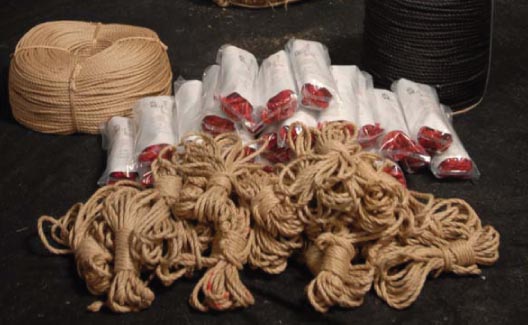What kind of rope should I use for Shibari/Kinbaku?
If you’re interested in restrictions in general and everything that is commonly related with “occidental bondage”, you may use the ropes you want. But if you’re trying to practice Shibari/Kinbaku (traditional Japanese bondage), and start doing things the right way and not just say some words in an difficult language, I recommend you not only to wisely choose your source of knowledge, but also choose some ropes made of organic fibers.

Jute or Hemp?
In Japan the most popular election is 6 millimeter jute rope, although they use other kind of organic ropes depending on the final results they want to achieve. It is my personal thinking that Japanese bakushis somehow prefer jute over hemp because of the lightness, it’s ductility, and it’s nice appearance. Besides it seems there is no Japanese word for “hemp” since the word is the same for both materials.
Due to the way Shibari/Kinbaku is done, the rope used should have a good grip so to ensure the knots would stay there, without any unwanted slipping. Also the rope should not be totally elastic. Organic ropes do not get hot while they rub against the model’s skin, and that lessen the possibility of burning the model’s skin. Ropes with 6 millimeters diameter and three laced cords inside are the one frequently chosen as they allow reasonable size knots and make up a beautiful pattern that gets imprinted in the model’s skin for some minutes when you untie them.
In my personal opinion I feel hemp a bit rustic and too heavy between my fingers. That makes it more difficult for my energy to freely flow through it. But once again, this is a matter of tastes… There are people that say that it’s sweet and particular smell flooding the room incentives them to get into the mood. On the other hand I feel very exciting and stimulating the creaking sound of jute against bamboo or just against itself, specially in high tension. Due that hemp is a heavier material, it usually gains more speed while flying in the air, and it may lead the bakushi to need an extra skill to control the rope’s ends movement.
With long use you may see hemp gets rougher. On the other side jute gets softer with every use. You can take care of both materials with oils, waxes, and rapidly passing them over a flame. Each bakushi has it’s secret way on how to take care of the ropes and that is sometimes very personal.
If you need help choosing your first ropes, follow this link
